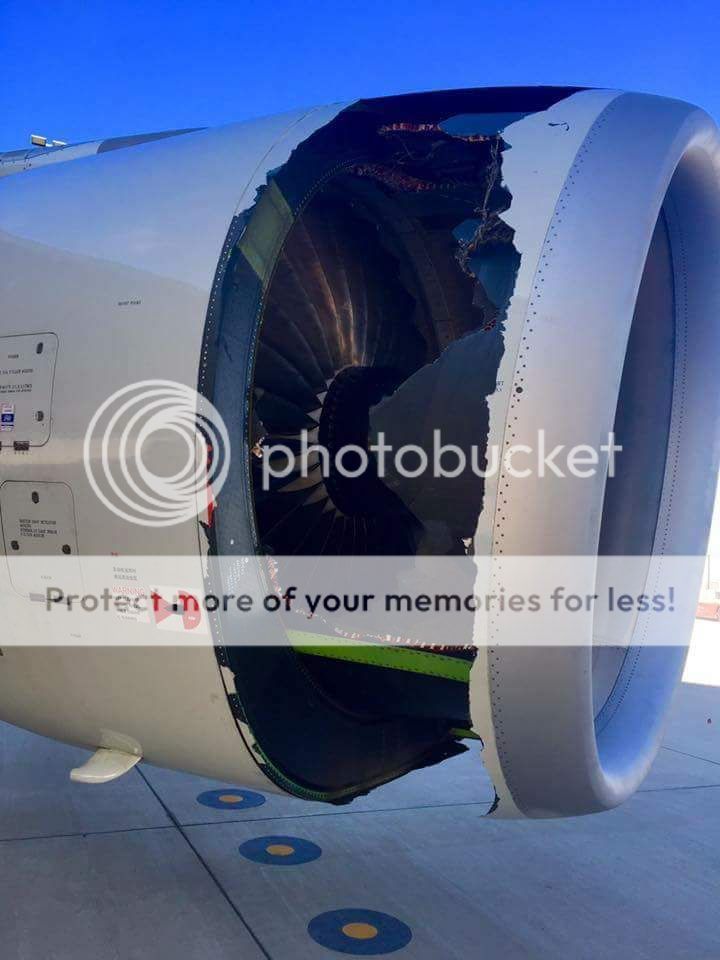It looks like you're using an Ad Blocker.
Please white-list or disable AboveTopSecret.com in your ad-blocking tool.
Thank you.
Some features of ATS will be disabled while you continue to use an ad-blocker.
share:
a reply to: Zaphod58
Zaph,
Agree on the propagation idea right there. The AD regarding the combustion liner should be a bit more aft on the engine that this. I guess it's possible, but I can't see the combustion liner AD having an impact on the cowling forward of the fan.
Great pics. I can't believe that Rolls isn't freaking out, right about now.
Zaph,
Agree on the propagation idea right there. The AD regarding the combustion liner should be a bit more aft on the engine that this. I guess it's possible, but I can't see the combustion liner AD having an impact on the cowling forward of the fan.
Great pics. I can't believe that Rolls isn't freaking out, right about now.
originally posted by: Zaphod58
a reply to: thebozeian
The only thing that I can think of is that either the cracks are allowing corrosion in the outer skin of the cowling, or when the inner lining fails, it pulls on the cowling, and damages it until it fails, and starts a tearing of the cowling.
Yes, and those things are laminated, so there is likely the tearing, and 'peeling' until such time the whole structure is torn away within a parameter of a sort.
originally posted by: iTruthSeeker
Weird.. The blades on the inside look perfectly fine. From another pic. So I saw a comment that this has nothing to do with Airbus, and that the airlines are who pick which engine they want in it? Is this true Zaph?
I'll ump in here since I'm working on an A330 type rating. Airbus gives the customer 3 choices of engines; General Electric CF6, Pratt & Whitney PW4000, and Rolls-Royce Trent 700.
originally posted by: Zaphod58
a reply to: Outlier13
Landing overweight could be more dangerous than flying with one engine shutdown. There is a very real danger of damage to the airframe of a landing gear collapse if they land too heavy.
Actually, if you comply with the Overweight Landing checklist, you can land the A330 at weights up to Maximum Gross Takeoff weight. In fact, the stock 330 doesn't come with fuel dumping capability, although I understand it can be ordered as an option. The other factor that might require a fuel dump or burn off is runway length requirement. Brake energy limits are affected by weight. Another consideration is that the 330 is a twin engine jet and with one engine out reverse thrust is going to be asymetric so you might not want to go into full reverse meaning more runway is needed.
a reply to: iTruthSeeker
Sorry, missed your engine question. As F4Guy said, they offer three engines for the A330,and the customerpicks which one is used. Most aircraft have at least two engine options they can pick from. Some, like the 737 only use one specific engine type.
Sorry, missed your engine question. As F4Guy said, they offer three engines for the A330,and the customerpicks which one is used. Most aircraft have at least two engine options they can pick from. Some, like the 737 only use one specific engine type.
a reply to: F4guy
Yes all true F4guy. As I said before there is no provision for fuel dumping on the -300 and it is an option on the -200. I'm not sure how many customers have taken up the option but I believe a fair few. I omitted the braking/RTO side of the reasoning and loss of 50% of your T/R ability is a good point in regards to runway length.
Yes all true F4guy. As I said before there is no provision for fuel dumping on the -300 and it is an option on the -200. I'm not sure how many customers have taken up the option but I believe a fair few. I omitted the braking/RTO side of the reasoning and loss of 50% of your T/R ability is a good point in regards to runway length.
a reply to: Zaphod58
Some of the conclusions people are reaching on this are pretty wild and frankly stupid. I saw that quote from an unnamed "expert" concluding something might not have been tightened in the engine properly. If ever there was a lazy arsed troubleshoot conclusion that would be it, and it is almost certainly wrong. This is still looking like a either a failure in the thermal anti ice system or water ingress under the acoustic liner. And while I'm here I should clarify something I said yesterday when I implied that the acoustic liner isn't structural. Whist the liner by itself isn't a structural member it is part of a sandwich with a honeycomb core and outer layer. Therefore if enough liner was to disbond it would expose the core to the inlet pressures and could rapidly collapse from the partial vacuum like suction with the engine under power. To illustrate the point I was making yesterday about the acoustic panels, take a look at this image I took today of a TRENT 900 inlet which is similar and representative of most of these liners.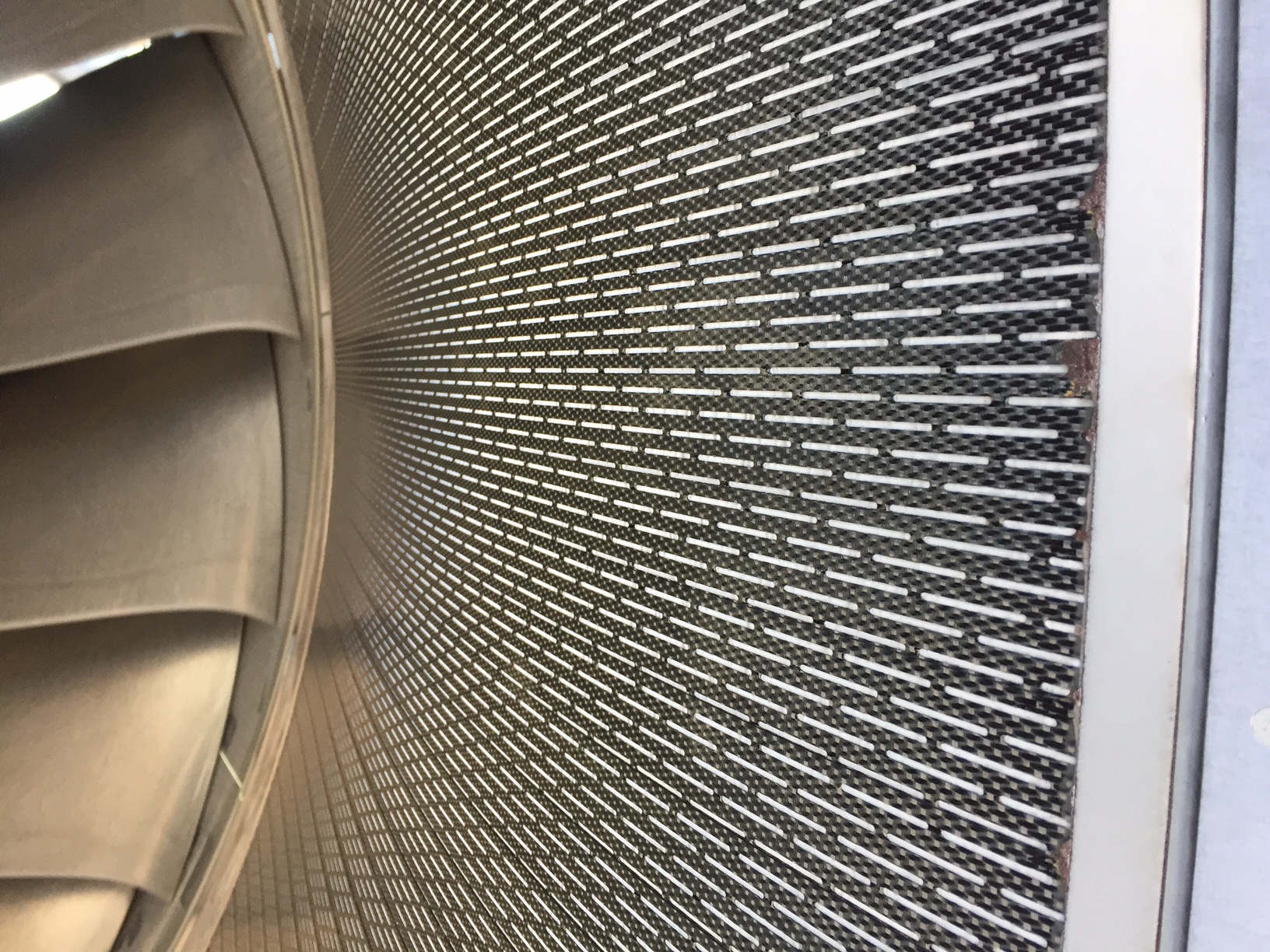
As an update the aircraft appears to still be on the ground this afternoon and I suspect they are waiting on a replacement engine as there were quite a few nicked fan blades as well as possible core ingestion of material and a cowl change. Probably quicker to drop the motor than rectify the damage and carry out inspections. That would make two foreign carriers with engine changes in a couple of days here, yesterday a Scoot 787 required a Trent 1000 unscheduled replacement.
Some of the conclusions people are reaching on this are pretty wild and frankly stupid. I saw that quote from an unnamed "expert" concluding something might not have been tightened in the engine properly. If ever there was a lazy arsed troubleshoot conclusion that would be it, and it is almost certainly wrong. This is still looking like a either a failure in the thermal anti ice system or water ingress under the acoustic liner. And while I'm here I should clarify something I said yesterday when I implied that the acoustic liner isn't structural. Whist the liner by itself isn't a structural member it is part of a sandwich with a honeycomb core and outer layer. Therefore if enough liner was to disbond it would expose the core to the inlet pressures and could rapidly collapse from the partial vacuum like suction with the engine under power. To illustrate the point I was making yesterday about the acoustic panels, take a look at this image I took today of a TRENT 900 inlet which is similar and representative of most of these liners.

As an update the aircraft appears to still be on the ground this afternoon and I suspect they are waiting on a replacement engine as there were quite a few nicked fan blades as well as possible core ingestion of material and a cowl change. Probably quicker to drop the motor than rectify the damage and carry out inspections. That would make two foreign carriers with engine changes in a couple of days here, yesterday a Scoot 787 required a Trent 1000 unscheduled replacement.
edit on 13-6-2017 by thebozeian because: (no reason given)
edit on 13-6-2017 by thebozeian because: (no reason given)
That is not an engine failure. That is a failure of the intake structure. The linked news report has video of somebody inspecting the intake. You
can see the front compressor blades and the failure is in front of them. I haven't worked around an Airbus and my information is dated but, I seem to
remember something about vents in the intake structure. The purpose of the vents was to ensure that the air pressure inside the intake structure
equalized with the outside air pressure. I don't know if there are vents in that type of structure or not, but, to me that looks like what would
happen if those vents failed causing the structure to fail.
a reply to: thebozeian
When the Emirates bird lost the cowling in 2006 they came up with everything from the spacers used between the blades, to a partial blade failure. Nice to see they've come so far in random baseless speculation.
When the Emirates bird lost the cowling in 2006 they came up with everything from the spacers used between the blades, to a partial blade failure. Nice to see they've come so far in random baseless speculation.
edit on 6/13/2017 by Zaphod58 because: (no reason given)
Update: As I confidentially predicted a day or so ago the aircraft was moved today from open air parking to one of our hangars pending further
investigation and inspection by the ATSB and in preparation for an engine change. I got an opportunity to take a close look at the damage and took
quite a few pictures which I will upload here tomorrow night. What I can tell you is that up close the damage is even more catastrophic to the cowl
than the media images reveal. Fully half the inner cowling and liner are completely gone and nearly two thirds of the outer cowl has vanished with the
damage extending and probably only stopped from the NAI lower outlet at approx 4-5 O'clock and around and up to the 12 O'clock position. There is
secondary damage to NAI/TAI duct supports and I counted at least 10 fan blades with moderate damage, fortunately all in the outer third or so of the
blade where damage tolerances are more generous. It would appear that the failure started either at the 12 O'clock position or on the I/B side of the
cowl and spread. There is collapsing and compressing of the core honeycomb at 12 O'clock and an internal duct for the anti ice is visible as well as
the inlet pressure sense pick up line There appeared to be no missing or obviously damaged annulus fillers (the fairings between each blade root on
the hub). There appears to be little if any damage to the forward and aft titanium bulkheads of the cowl, nor could I see anything obvious in the cold
stream, to the A frames or LP turbine and exhaust. There was some very very minor damage to one trailing edge flap lower surface. What I can say is
that they were incredibly lucky that the NAI outlet stopped the damage. If it had peeled/collapsed in the opposite direction the entire cowl structure
would have failed and torn off, most likely striking the wing leading edge and pylon area. The resulting damage could have been extensive. A colleague
remarked that the very similar set up on other Trent engines has in the past revealed damage to internal baffle plates on the upper NAI outlet so if
the baffles did separate and block the outlet its possible that an overpressure could occur and lead to a blow out, slipstream would do the rest. I'll
upload the pics tomorrow when I have more time.
Oopps, there I was promising some pics and clean forgot about it. They ended up changing the engine about a week after the incident. Watching the
China Eastern AOG team work was interesting to say the least. At one point when they had dropped the engine they didn't have a tug available to move
it on the dolly so they just all got on the draw bar and pushed.
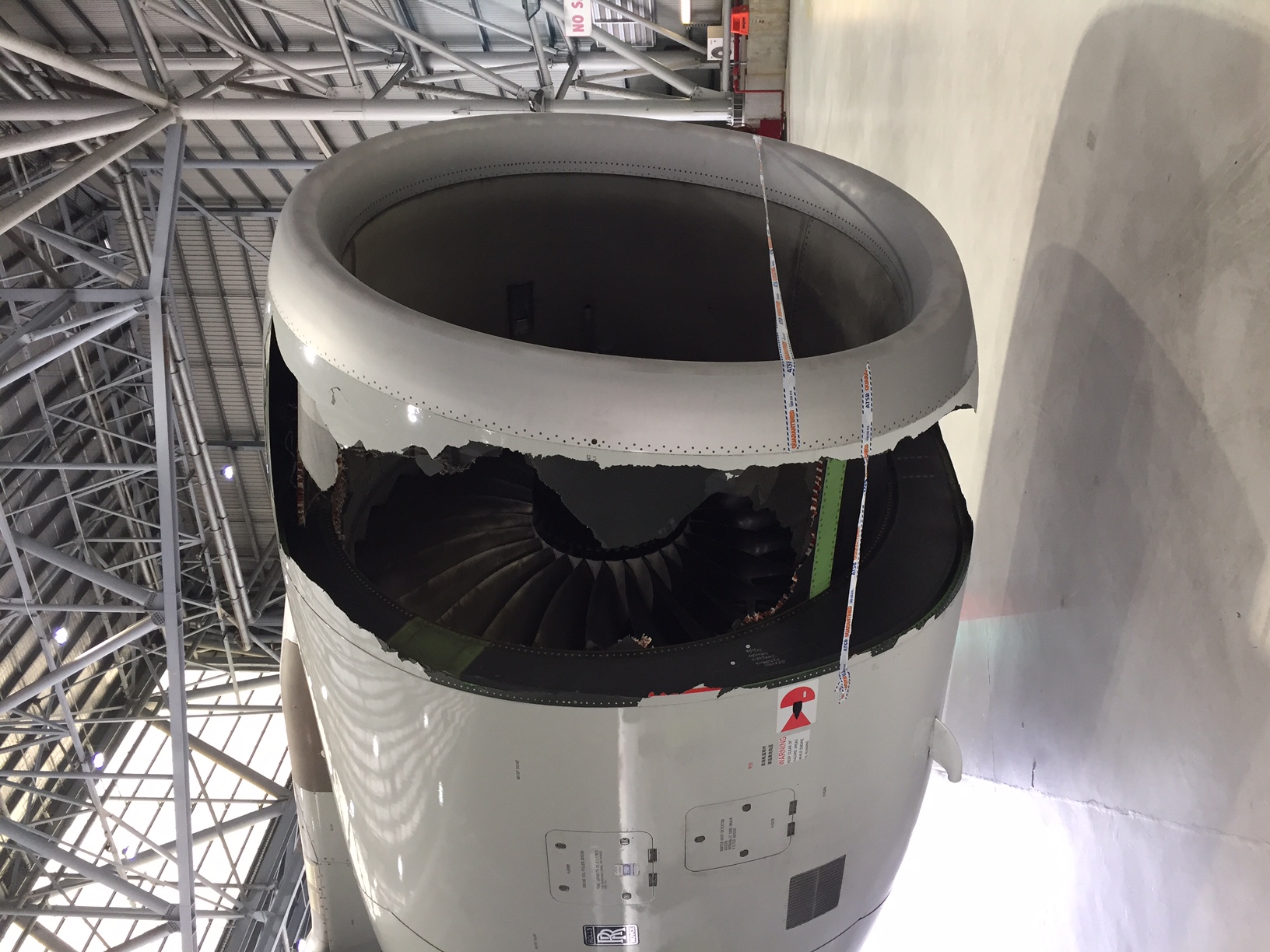
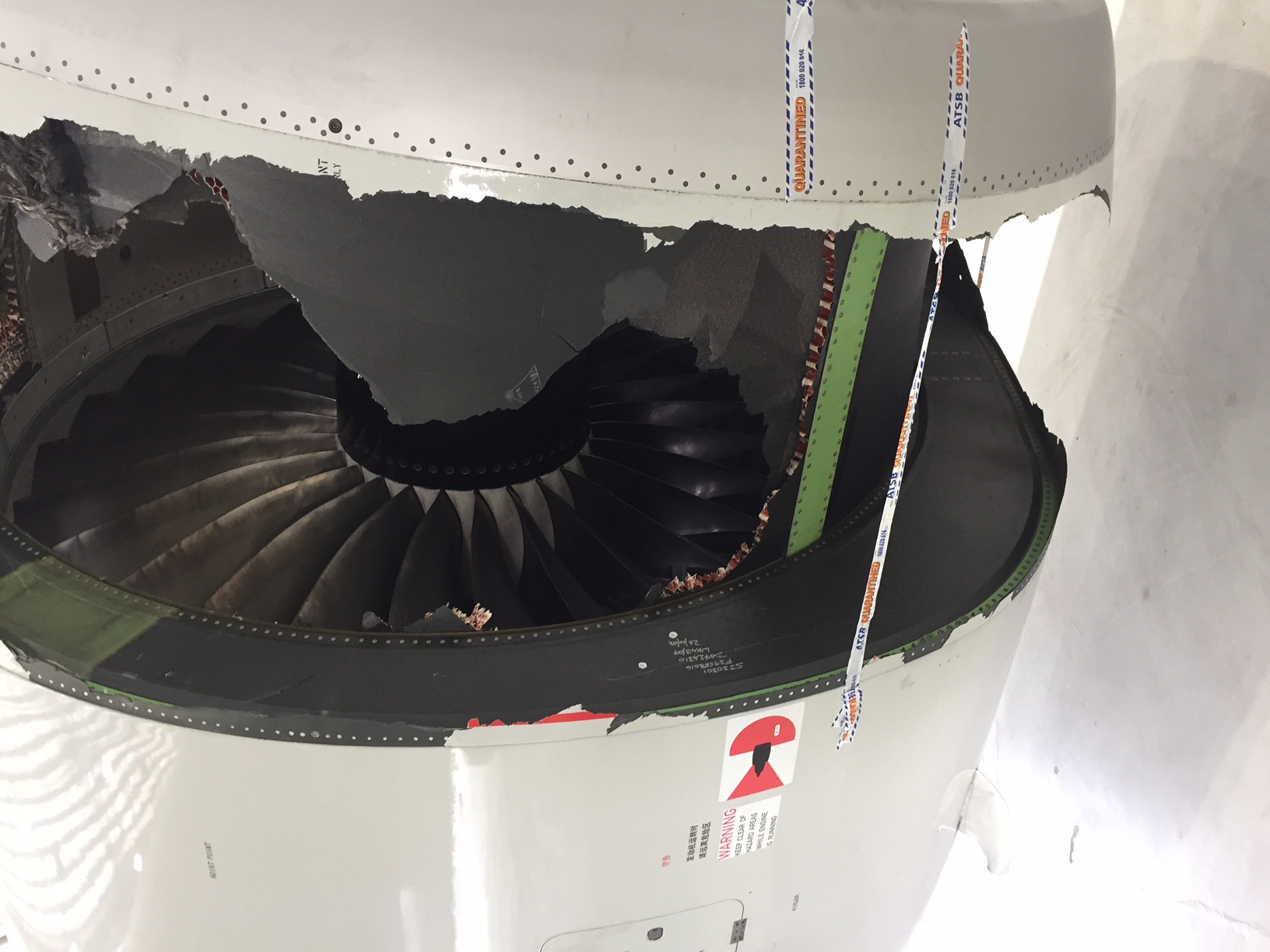
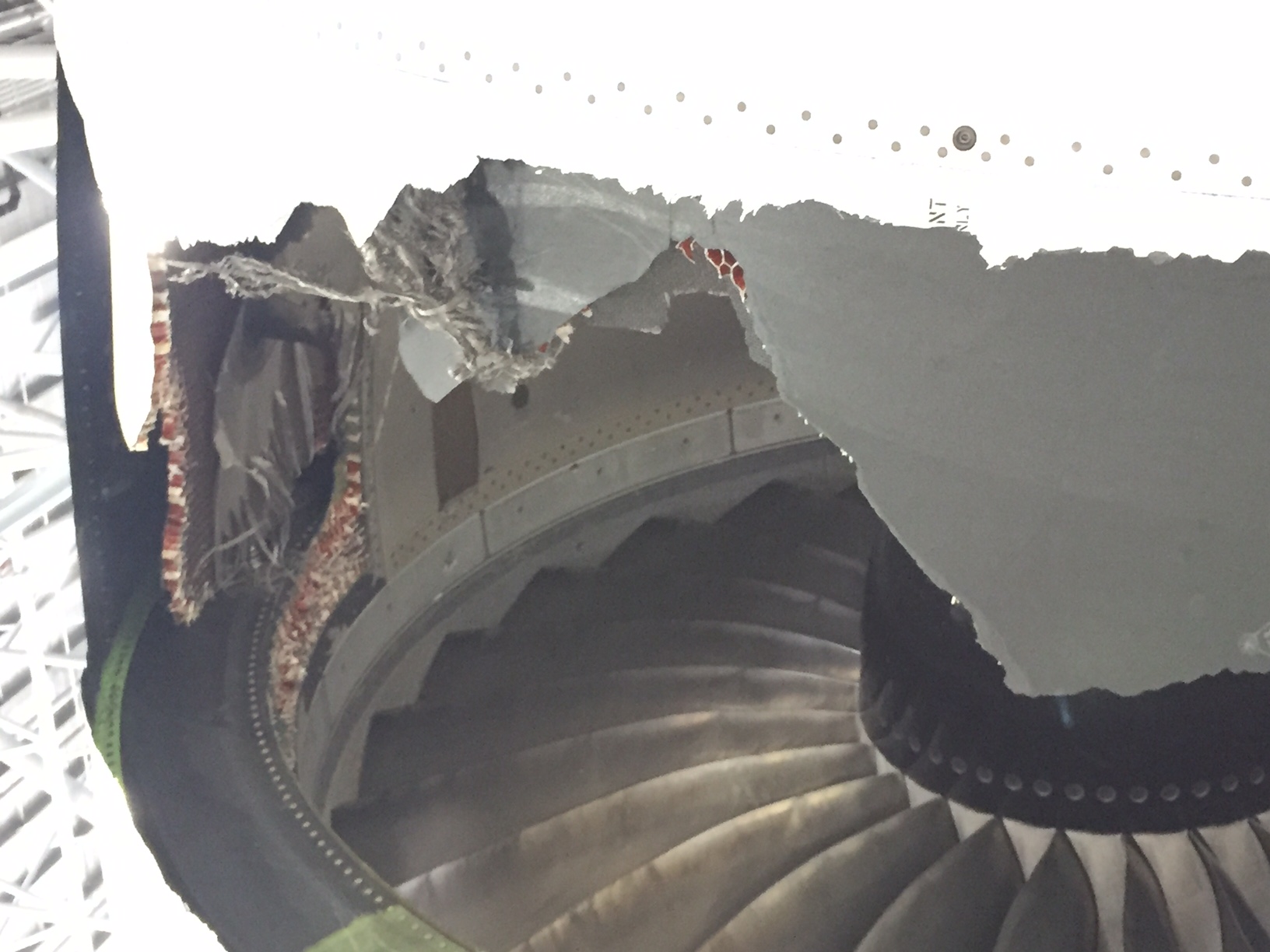
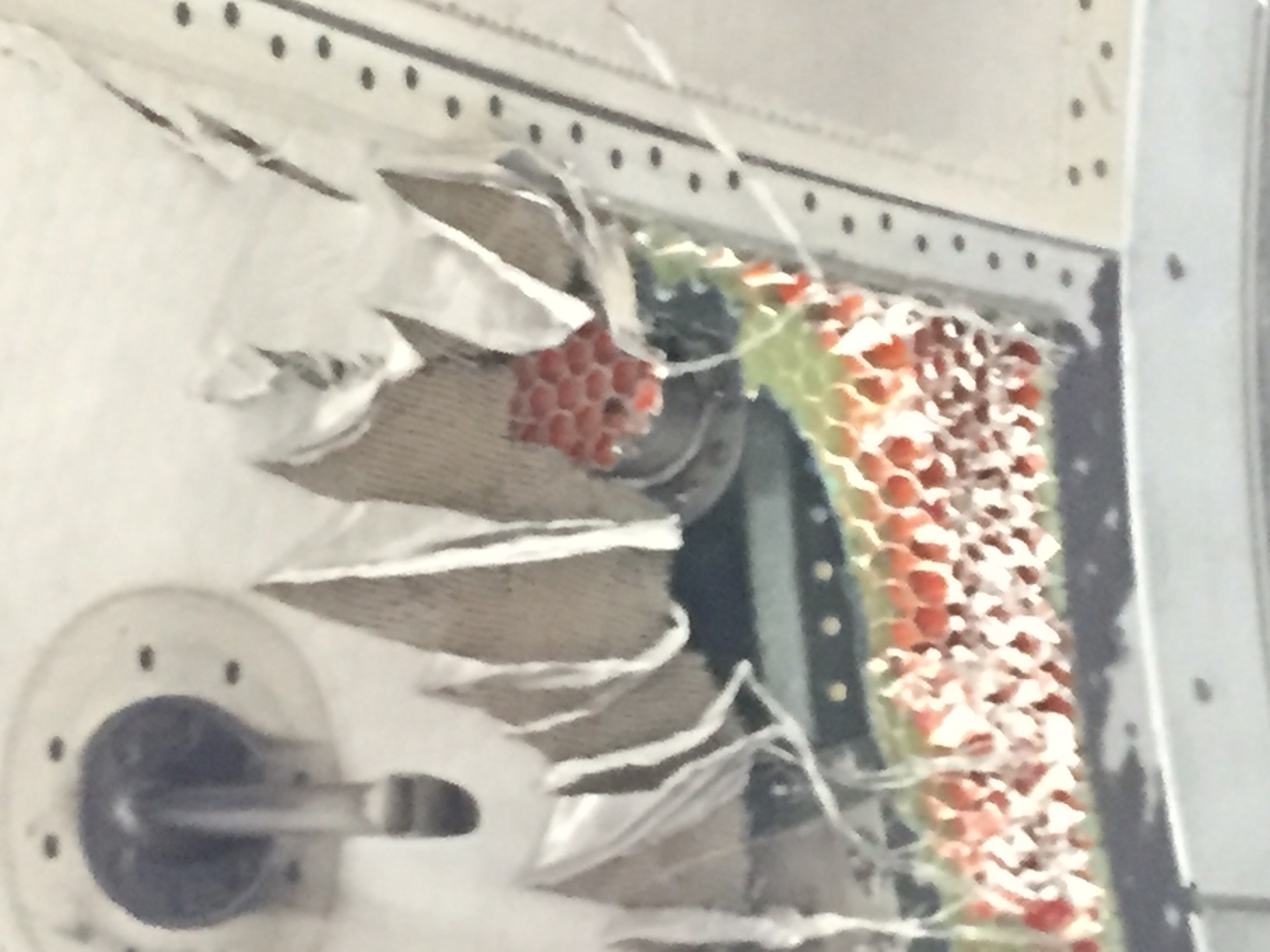
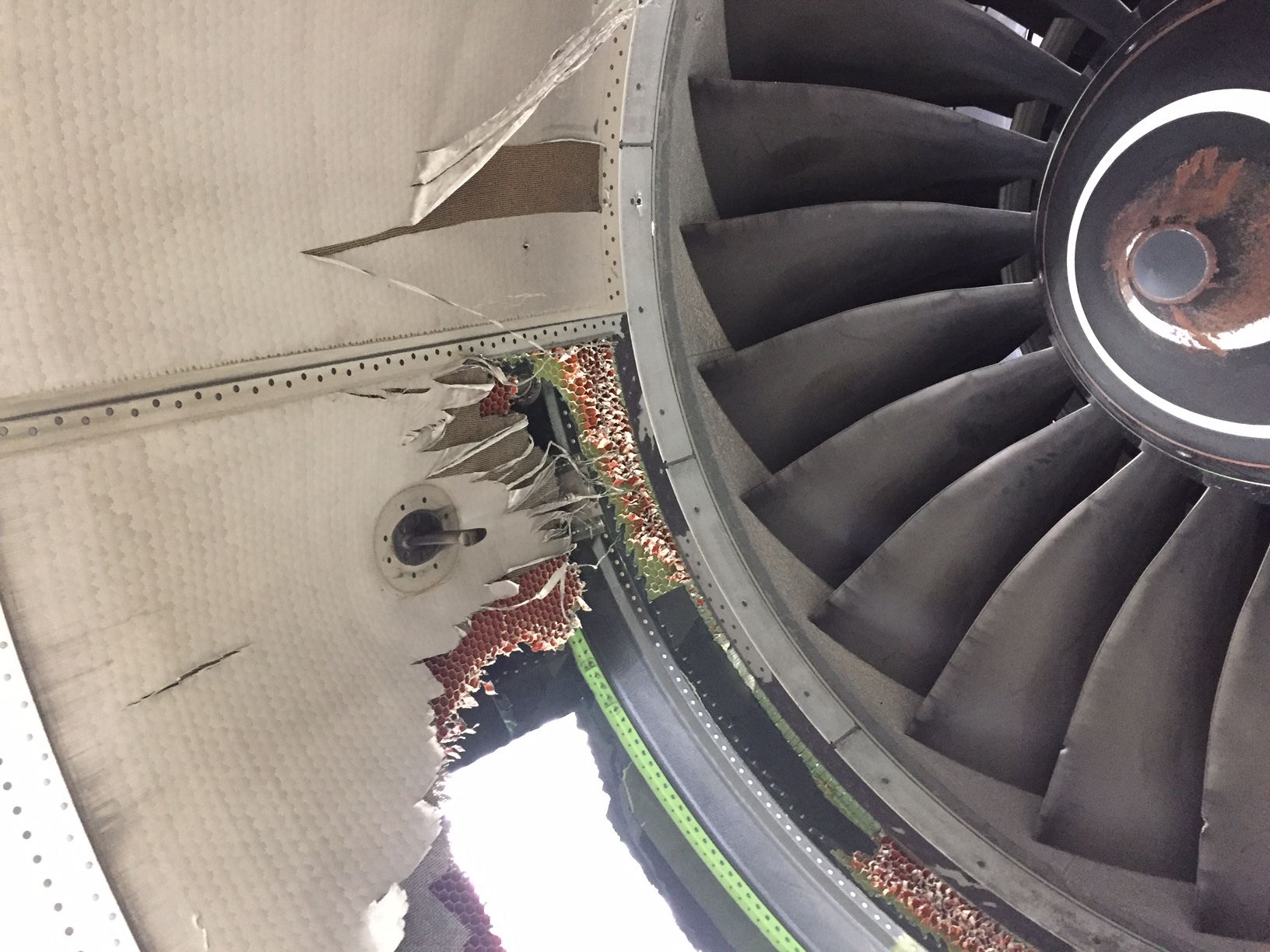
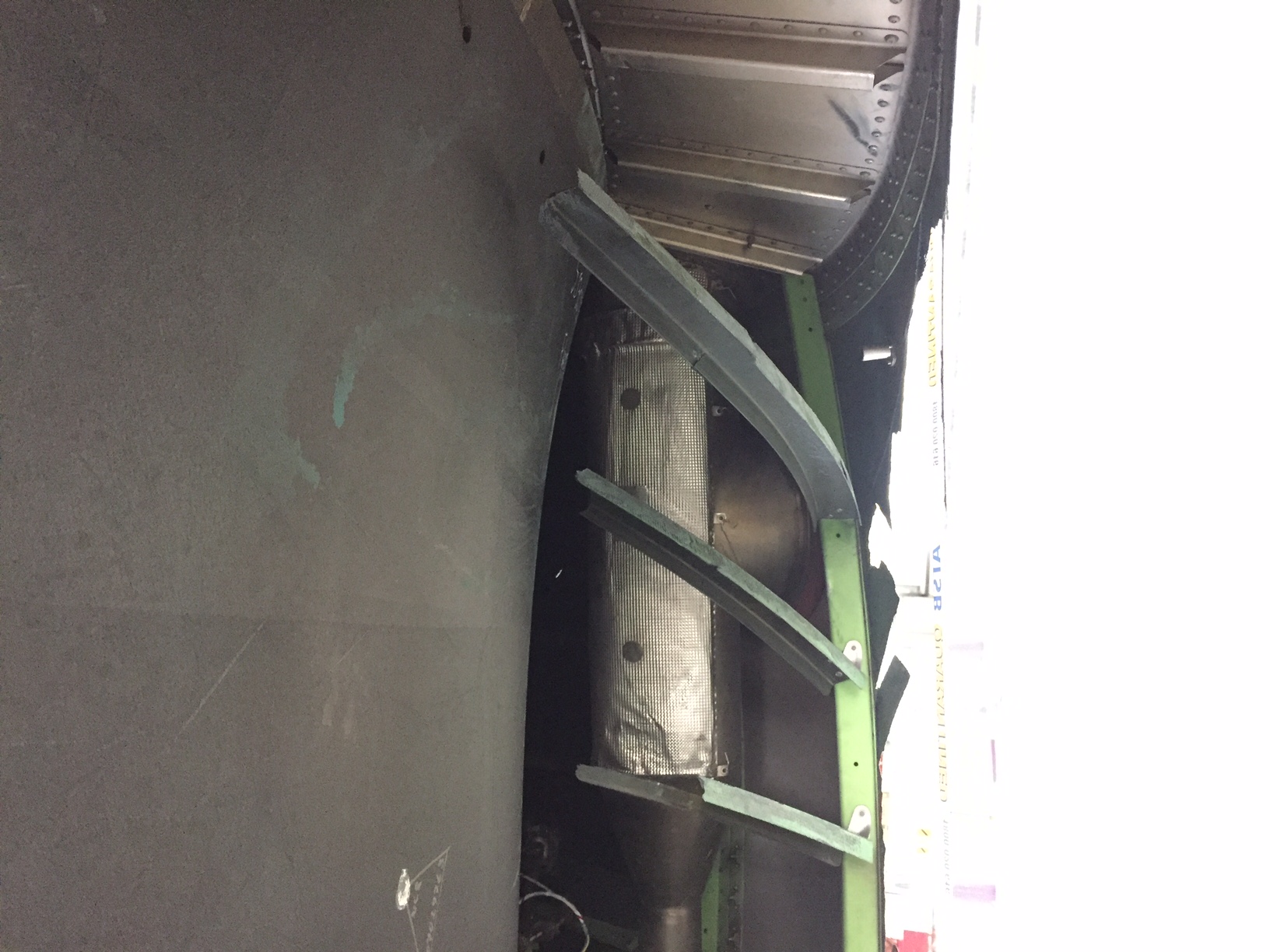

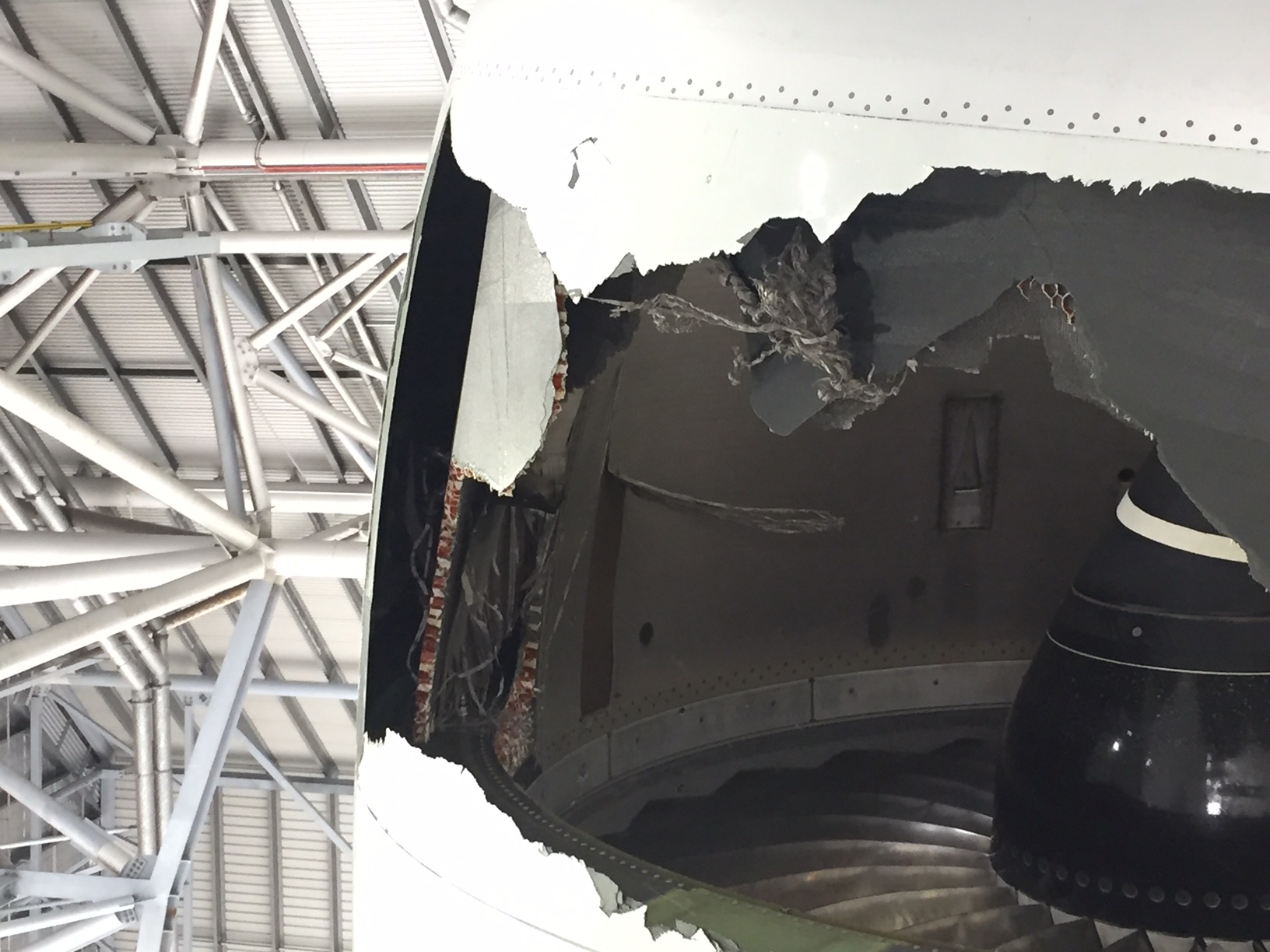
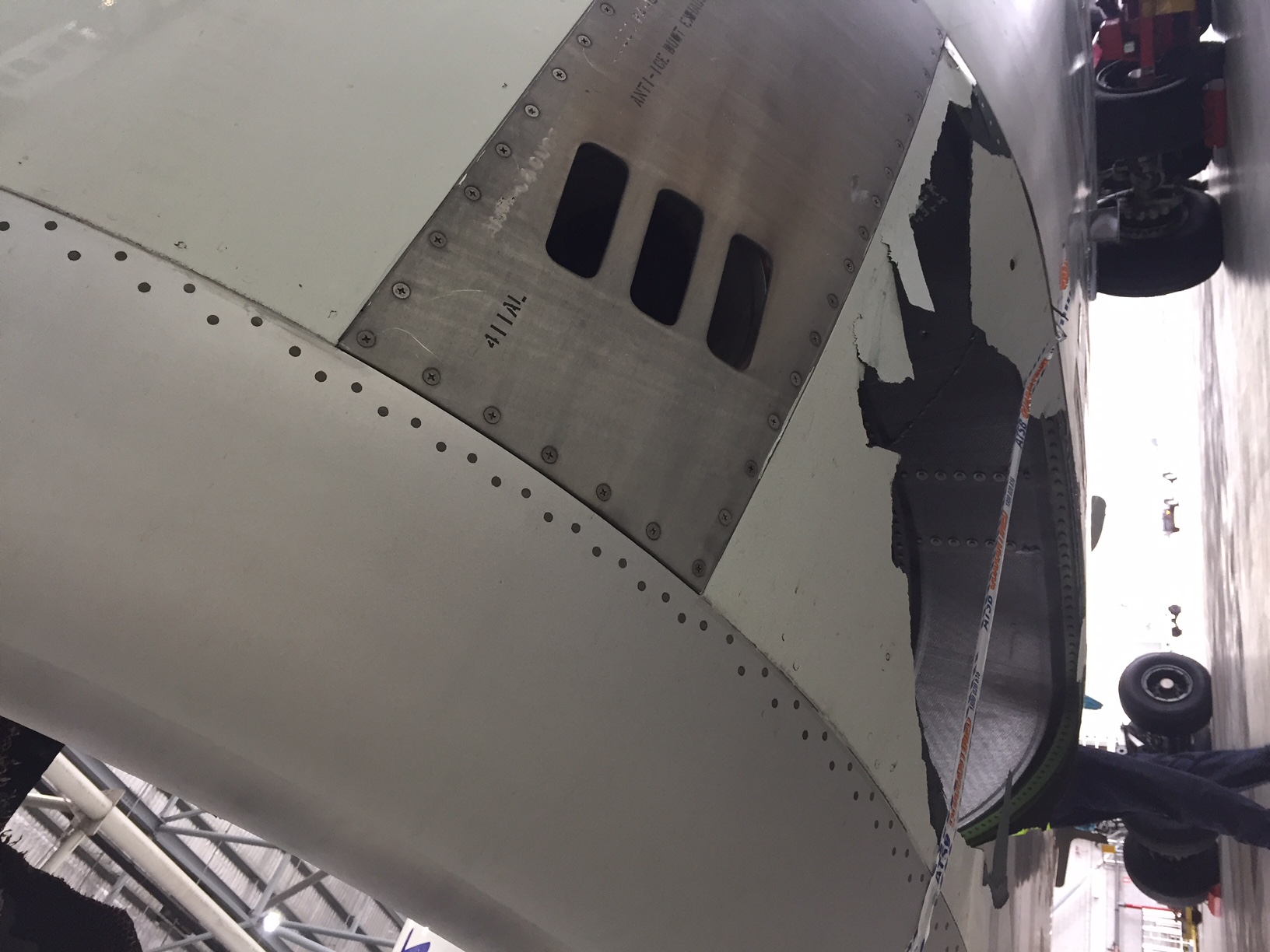
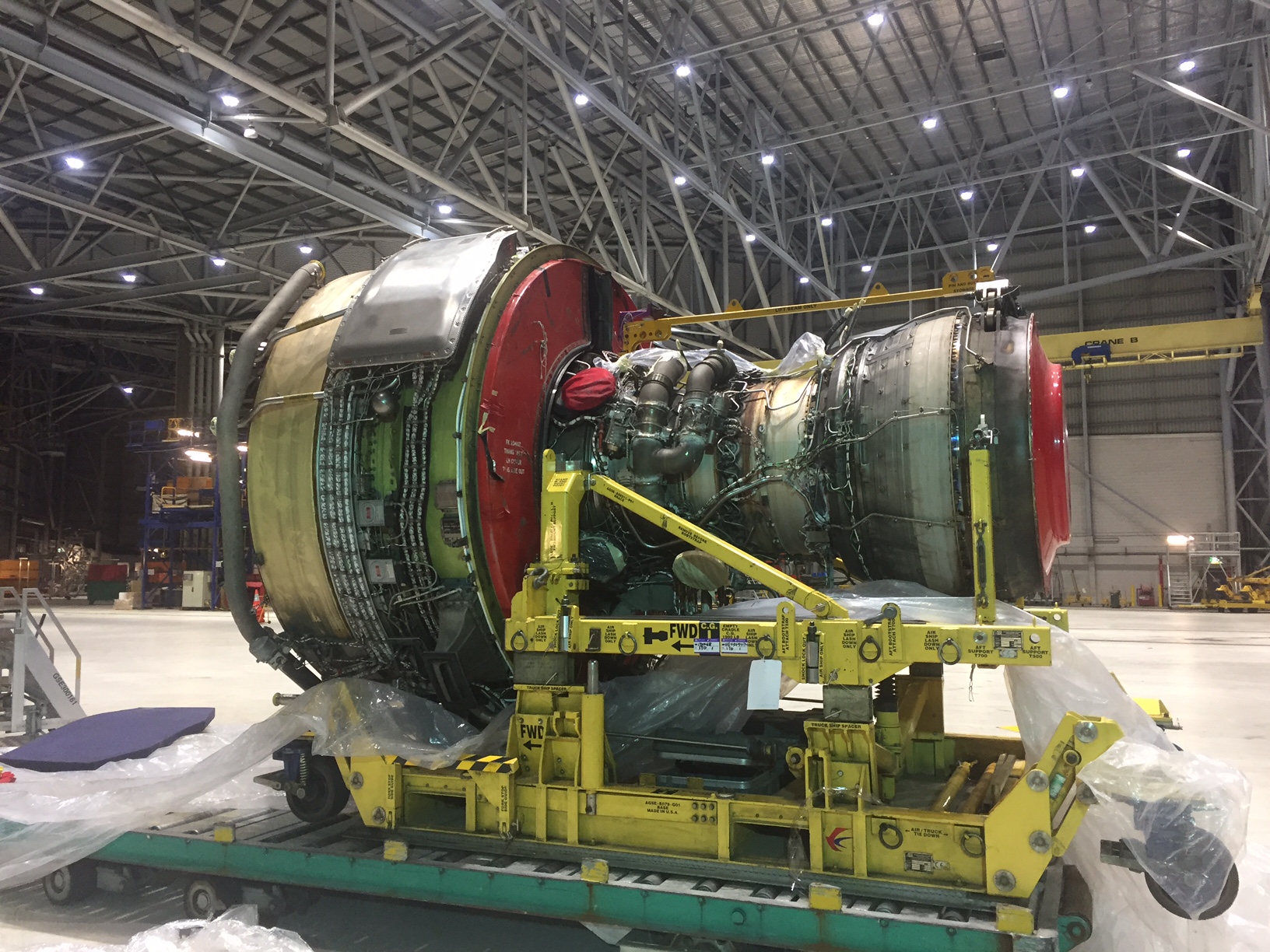










edit on 19-6-2017 by thebozeian because: (no reason given)
a reply to: thebozeian
A couple angles look like the honeycomb delaminated. It might just be the damage though.
A couple angles look like the honeycomb delaminated. It might just be the damage though.
edit on 6/19/2017 by Zaphod58 because: (no reason
given)
a reply to: Zaphod58
Yeah sorry the pics are all sideways dont know quite what happened. The honeycomb took some pretty hard hits and the whole sandwich collapsed on itself and telescoped into the void where the bleed air duct runs at the top between the outer shell and the back of the acoustic panels. You can see in one shot where the damage was only stopped by the lower bleed outlet structure and the internal bracing supports around it were snapped. A lot of material was sucked into the core I was told and you can see brownish coloured staining on the tip of the spinner indicating where it hit first. All up at least 10 fan blades took some hits as well as a few dings to the trailing edge flaps and the wing leading edge. Its a miracle the thing actually stayed on. No word yet as to what caused the failure.
Yeah sorry the pics are all sideways dont know quite what happened. The honeycomb took some pretty hard hits and the whole sandwich collapsed on itself and telescoped into the void where the bleed air duct runs at the top between the outer shell and the back of the acoustic panels. You can see in one shot where the damage was only stopped by the lower bleed outlet structure and the internal bracing supports around it were snapped. A lot of material was sucked into the core I was told and you can see brownish coloured staining on the tip of the spinner indicating where it hit first. All up at least 10 fan blades took some hits as well as a few dings to the trailing edge flaps and the wing leading edge. Its a miracle the thing actually stayed on. No word yet as to what caused the failure.
a reply to: thebozeian
It's almost got to be an acoustic panel delamination, causing a collapse of the structure. That's about the only thing that makes sense with where it's located and the damage.
It COULD be related to one of the air systems I guess, but there doesn't seem to be any damage to any of them in any of the incidents.
It's almost got to be an acoustic panel delamination, causing a collapse of the structure. That's about the only thing that makes sense with where it's located and the damage.
It COULD be related to one of the air systems I guess, but there doesn't seem to be any damage to any of them in any of the incidents.
a reply to: Zaphod58
Yes its still hard to say. I have been told by a colleague that he saw some damage to internal baffles at the 12 O'clock position on another Trent that could break off and block the outlet but you would think it couldn't cause that much of an overpressure. But its also hard to believe that there could be that much damage to the underlying acoustic liner to honeycomb interface that would cause such a sudden and dramatic failure.
Guess we just have to wait for the ATSB report?
Yes its still hard to say. I have been told by a colleague that he saw some damage to internal baffles at the 12 O'clock position on another Trent that could break off and block the outlet but you would think it couldn't cause that much of an overpressure. But its also hard to believe that there could be that much damage to the underlying acoustic liner to honeycomb interface that would cause such a sudden and dramatic failure.
Guess we just have to wait for the ATSB report?
a reply to: thebozeian
I haven't seen any firm cause from the one in 2006, so I'm not holding my breath on this one.
I haven't seen any firm cause from the one in 2006, so I'm not holding my breath on this one.
new topics
-
Only two Navy destroyers currently operational as fleet size hits record low
Military Projects: 5 hours ago -
George Stephanopoulos and ABC agree to pay $15 million to settle Trump defamation suit
Mainstream News: 10 hours ago
top topics
-
George Stephanopoulos and ABC agree to pay $15 million to settle Trump defamation suit
Mainstream News: 10 hours ago, 17 flags -
More Bad News for Labour and Rachel Reeves Stole Christmas from Working Families
Regional Politics: 17 hours ago, 8 flags -
Only two Navy destroyers currently operational as fleet size hits record low
Military Projects: 5 hours ago, 7 flags
active topics
-
-@TH3WH17ERABB17- -Q- ---TIME TO SHOW THE WORLD--- -Part- --44--
Dissecting Disinformation • 3689 • : duncanagain -
A Bunch of Maybe Drones Just Flew Across Hillsborough County
Aircraft Projects • 83 • : charlyv -
The Mystery Drones and Government Lies
Political Conspiracies • 72 • : tarantulabite1 -
Only two Navy destroyers currently operational as fleet size hits record low
Military Projects • 1 • : alwaysbeenhere2 -
A priest who sexually assaulted a sleeping man on a train has been jailed for 16 months.
Social Issues and Civil Unrest • 30 • : alwaysbeenhere2 -
They Know
Aliens and UFOs • 86 • : ianmoone3 -
George Stephanopoulos and ABC agree to pay $15 million to settle Trump defamation suit
Mainstream News • 11 • : WeMustCare -
President-Elect DONALD TRUMP's 2nd-Term Administration Takes Shape.
Political Ideology • 331 • : WeMustCare -
Nov 2024 - Former President Barack Hussein Obama Has Lost His Aura.
US Political Madness • 15 • : WeMustCare -
Former DNI-Congressman John Ratcliffe says the U.S. Government is Intimidated by UFOs.
Aliens and UFOs • 41 • : WeMustCare

